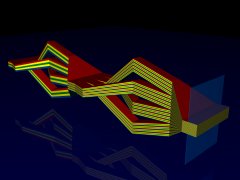Mar 29 2009
An innovation in flat extrusion die systems makes it possible to multiply key functional layers in cast film and sheet, substantially improving properties without increasing either overall thickness or raw material content, it was announced today by Extrusion Dies Industries, LLC (EDI), which will introduce the technology at NPE2009 (Booth 85007).
 Schematic showing how EDI’s layer multiplier system transforms a 7-layer structure into 82 layers. At left, a sandwich of 5 internal or core layers emerges from a feedblock (not shown) and is multiplied by 4 to yield 20 layers, then by 4 again to yield 80; at right, 2 skin layers are added for a total of 82.
Schematic showing how EDI’s layer multiplier system transforms a 7-layer structure into 82 layers. At left, a sandwich of 5 internal or core layers emerges from a feedblock (not shown) and is multiplied by 4 to yield 20 layers, then by 4 again to yield 80; at right, 2 skin layers are added for a total of 82.
The new “microlayer” technology enables extrusion processors and converters to achieve increases in impact strength, elongation, oxygen and moisture barrier, and other properties, according to EDI. Potential applications range widely, from industrial wraps to rigid and flexible barrier packaging.
The key to the improvements is special tooling developed by EDI to implement a coextrusion process designed and patented by The Dow Chemical Company. Called a “layer multiplier,” the flat die system transforms a typical sandwich structure from a standard coextrusion feedblock into a structure in which one or more of the layers has been subdivided into multiple microlayers. The overall thickness of the resulting coextrusion is no greater than if the original sandwich structure had been transferred directly from the feedblock to the extrusion die, without the intervention of the layer multiplier.
“Drawing on work that EDI carried out under a U.S. Department of Defense contract for developing long-shelf-life containers for military food supplies, we have further adapted our layer multiplier system to selectively multiply only the functionally critical layer materials in a coextrusion sandwich, such as the barrier layers,” said Gary D. Oliver, vice president of technology. “Without adding even a tiny increment in the amount of barrier resin used for a given volume of product, this proliferation of layers creates synergistic effects that reduce oxygen ingress from 3 to 5 times in comparison with a conventional barrier coextrusion.”
As an example, Oliver cited the case of a standard rigid barrier packaging container. While a conventional structure for this application has a single barrier layer, a structure produced with the EDI’s layer-multiplier system has four micro barrier layers (see cross sectional photos). The amount of barrier material is the same in both structures, but the oxygen transmission rate for the A and B sides of the one-barrier layer structure is substantially greater than for those of the four-barrier layer structure.
In stretch film, similarly, EDI has demonstrated improvements in tensile properties by alternating multiple layers of “performance” materials with commodity resins. In one series of tests, EDI compared 1) a standard five-layer polyethylene structure having outer “cling” layers and a core consisting of three linear low-density polyethylene (LLDPE) layers with hexene, butene, and hexene co-monomer side chains, respectively; 2) a 14-layer structure, with the core multiplied four times; and a 50-layer structure with the core multiplied 16 times. Layer multiplication substantially increased strength properties and the key “stretch” property of elongation.